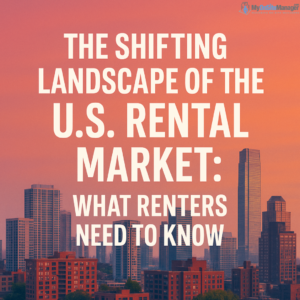The U.S. rental market is experiencing subtle yet significant changes that could impact renters in the coming months. After a period of relative stability, February saw the first rent increase in six months, with the median asking rent rising 0.4% year-over-year to $1,607—the largest gain in nine months. While this increase may seem modest, it signals a potential turning point for renters who have enjoyed a period of declining or stagnant rental prices.
According to a recent National Mortgage Professional article, renters who have benefited from discounts, concessions, and stable prices should brace themselves for potential changes. Let’s take a deeper dive into what’s happening in the rental market and what renters should expect moving forward.
A Period of Stabilization After Volatility
Over the past ten months, the rental market has stabilized—a notable shift from the dramatic fluctuations witnessed during the pandemic. In 2021, rents surged by up to 18% annually, driven by increased demand, migration trends, and economic shifts caused by COVID-19. This was followed by a cooling period in 2023, where rents declined by as much as 4% in certain markets.
Now, as the dust settles, we’re seeing a near equilibrium between rental supply and demand. This stability has been reassuring for renters, but experts warn that the window for discounted rents may soon close.
A Slowdown in Apartment Construction: A Future Rent Hike Indicator?
One major factor influencing the rental market’s trajectory is the slowdown in apartment construction. While a record 142,900 new apartments were completed in the third quarter of 2024, leasing has slowed. Only 47% of these newly built apartments were rented within three months—a historic low absorption rate outside of the early days of the pandemic.
At the same time, builders are pulling back. Permits for new apartment construction have decreased nearly 10% year-over-year, meaning that fewer rental units will be available in the future. As supply tightens, landlords will likely gain more pricing power, allowing them to increase rents and reduce tenant perks such as move-in discounts, free parking, or reduced security deposits.
According to Redfin Senior Economist Sheharyar Bokhari, renters should be aware that the benefits they currently enjoy—such as lower prices and incentives to sign leases—may not last long. However, the shift will not be immediate. Many apartments built during the pandemic are still entering the market, which should keep prices somewhat stable for the short term.
Regional Variations: Where Are Rents Rising and Falling?
Although the national median rent has inched upward, trends vary widely by region. Some cities continue to see rental price declines, while others are experiencing rent hikes due to limited housing supply.
Markets Where Rents Are Declining:
- Austin, TX: -9.4% year-over-year ($1,404 median rent)
- Salt Lake City, UT: -7.8%
- Jacksonville, FL: -6.7%
- Minneapolis, MN: -5.9%
- San Diego, CA: -5.6%
Austin, in particular, has seen a sharp drop in rental prices, with median rents now 22% lower than their August 2023 peak. Cities with high construction rates, such as Texas and Florida metro areas, have more available units, which keeps rental prices in check.
Markets Where Rents Are Increasing:
- Cincinnati, OH: +15.3%
- Providence, RI: +12.4%
- Baltimore, MD: +9.6%
- Washington, D.C.: +9.2%
- Cleveland, OH: +8.5%
In contrast, cities with limited new apartment construction, such as Cincinnati and Baltimore, are seeing significant rent hikes. With fewer housing options, landlords in these areas have been able to push prices higher.
Growing Demand for Smaller Apartments
With rising costs and economic uncertainty, many renters are opting for smaller, more affordable living spaces. The demand for studio and one-bedroom apartments remains strong, and landlords are responding accordingly.
- Studio and one-bedroom apartments: Rents increased by 0.4% to $1,467, marking their first price increase since June 2024.
- Two-bedroom apartments: Rents rose by 0.6% to $1,689.
- Three-bedroom or larger units: Rents declined by 0.5% to $1,990, although the drop was smaller than in previous months.
Notably, the leasing rate for newly built studio apartments has improved. In the past year, 50% of new studios were rented within three months, compared to just 42% the year before. However, larger units have been slower to lease, reflecting changing renter preferences.
What Does This Mean for Renters?
For renters, the key takeaway is that the era of rent decreases and widespread incentives may be ending. However, the shift won’t happen overnight.
If you’re looking to move, consider these strategies:
-
Lock in a Lease Now: If you find a good rental deal or a landlord offering concessions, it may be wise to secure a longer lease before prices rise.
-
Monitor Regional Trends: While some cities are seeing rent hikes, others continue to offer discounts. Researching local trends can help you make an informed decision.
-
Consider Smaller Units: If affordability is a concern, smaller apartments may offer better value as they remain in high demand but are still competitively priced.
-
Negotiate Perks: While discounts may start disappearing, some landlords may still be willing to offer move-in incentives, especially in cities with high vacancy rates.
-
Keep an Eye on New Developments: The slowdown in construction won’t impact the market immediately, but within a year or two, tighter supply could drive rents up further.
Conclusion
The U.S. rental market is shifting once again. After a period of falling or stable rents, a combination of rising demand and slowing new construction is setting the stage for future price increases. While renters in cities with high apartment availability may still find good deals, those in areas with limited supply could see rents climb higher.
The best approach? Stay informed, act strategically, and take advantage of any remaining deals before the market fully shifts.
Source: National Mortgage Professional – Renters Beware: Discounts May Disappear

